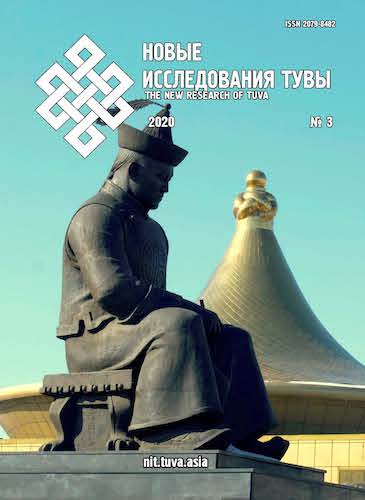Transformation of the image of a woman of nomadic culture in Tuvan literature: the works by A. M. Lamazhaa
DOI:
https://doi.org/10.25178/nit.2020.3.16Keywords:
Tuvan literature; Tuvans; history of Tuva; Tuvan shamanism; shaman; shamaness; image of a woman; Anna Mombuzhaevna LamazhaaAbstract
The article examines the changes in the portrayal of a woman of nomadic culture in the works of Tuvan writer, a descendant of a shaman family, medical doctor A. M. Lamazhaa. We examine her collection of short stories and a novel ‘The Roads of the Silver Shamanesses’ (2011, 2019). The culture of Tuvan nomads has been changing during the entire 20th century, and there were inevitable losses along the way. This process was accompanied by changes in the traditional system of values and the role of women in Tuvan society. A. M. Lamazhaa is among the few Tuvan writers who focused on the rarely addressed issue of the shamans’ fate. The image of a woman of the Tuvan nomadic culture has for the first time been recreated in the genre of a novel. At the same time, the writer makes use of the folklore and neo-mythologist elements in her text.
Both texts are written in the form of third-person objectified narration. But the author-narrator somewhat associates herself with the main character, which adds a degree of biographism to her work. There are four stages in the evolution of the image of a woman of nomadic culture: origin, formation, transformation, and affirmation. They correspond to the stages of evolution of a woman as a protector of nature: the guardian of traditional family values; the guardian of traditional kinship values; the modern woman as a keeper of the historical memory of generation and ethnicity.
References
Anaiban, Z. V. (2005) Zhenshchiny Tuvy i Khakasii v period rossiiskikh reform [Women of Tuva and Khakassia in the period of reforms in Russia]. Moscow, Institut vostokovedeniia RAN. 243 p. (In Russ.).
Anzhiganova, L. V. (2016) Zhenskii mir. Traditsionnye smysly i novye vyzovy [Women's world. Traditional meanings and new challenges]. Abakan, Publishing house of State University. 98 p. (In Russ.).
Basilov, V. N. (1995) Posviashchenie vo sne (rasskaz uzbekskogo muzykanta) [Initiation in a dream: a story by an Uzbek musician]. In: Shamanizm i rannie religioznye predstavleniia [Shamanism and early religious beliefs] / ed. by D. A. Funk. Moscow, TsEA RAN. 272 p. Pp. 36–48. (In Russ.).
Biche-ool, S. M. (2018) Traditsionnye brachno-semeinye otnosheniya u tuvintsev i ikh transformatsiya v sovetskii period [Traditional matrimonial and family relations among the Tuvans and their transformation during the Soviet era]. Abakan, Zhurnalist. 125 p. (In Russ.).
Gachev, G. D. (1998) Natsional'nye obrazy mira [National images of the world]: a course of lectures. Moscow, Akademiia. 432 p. (In Russ.).
Dorzhu, Z. Yu. (2008) Zhenshchiny Tuvy: ot proshlogo k budushchemu [Women of Tuva: from the past to the future]. Kyzyl, TuvSU Publ. 184 p. (In Russ.).
Istoriia Tuvy [The History Of Tuva] (2016): in 3 vols. / ed. by V. A. Lamin. Novosibirsk, Nauka. Vol. 3. 455 p. (In Russ.).
Kenin-Lopsan, M. B. (1987) Obriadovaia praktika i fol'klor tuvinskogo shamanstva. Konets XIX — nachalo XX v. [Ritual practice and folklore of Tuvinian shamanism. Late XIX - early XX century.]. Novosibirsk, Nauka. 165 p. (In Russ.).
Meletinskii, E. M. (2006) Poetika mifa [The poetics of myth]. 4nd ed. Moscow, Vostochnaia literatura. 407 p. (In Russ.).
Mify, legendy, predaniya tuvintsev [Myths, legends and tales of the Tuvans] (2010). Ed. by V. V. Illarionov. Novosibirsk, Nauka. 372 p. (In Russ.).
Moskalenko, N. P. (2004) Etnopoliticheskaia istoriia Tuvy v XX veke [Ethnopolitical history of Tuva in the 20th century]. Moscow, Nauka. 222 p. (In Russ.).
Novik, E. S. (1984) Obriad i fol'klor v sibirskom shamanizme [Ritual and folklore in Siberian shamanism]. Moscow, Vostochnaia literatura. 304 p. (In Russ.).
Samdan, Z. B. (2019) Modifikatsiia arkhetipicheskogo obraza tuvinskogo shamana v tvorchestve M. B. Kenin-Lopsana [Modifications of the archetypal image of the Tuvan shaman in the works of M. B. Kenin-Lopsan]. The New Research of Tuva, no. 2, pp. 158–171. DOI: 10.25178/nit.2019.3.13
Sultanov, K. K. (2007) Ot Doma k Miru: etnonatsional'naia identichnost' v literature i mezhkul'turnyi dialog [From the home to the world: ethnonational identity in literature and intercultural dialogue]. Moscow, Nauka. 302 p. (In Russ.).
Yusufov, R. F. (1985) Obshchnost' literaturnogo razvitiia narodov SSSR v dooktiabr'skii period [Common features of the development of literatures of the peoples of the USSR in the pre-October period]. Moscow, Nauka. 267 p. (In Russ.).
Yusufov, R. F. (1996) Istoriosofiia i literaturnyi protsess: srednie veka i novoe vremia [Historiosophy and the literary process: the Middle Ages and modern times]. Moscow, Nasledie. 300 p. (In Russ.).
Yusufov, R. F. (2008) Ob istorii literatur narodov Rossii [On the history of literature of the peoples of Russia]. In: Mezhdunarodnye Lomidzevskie chteniia. Izuchenie literatur i fol'klora narodov Rossii i SNG [International Lomidze readings. Study of literature and folklore of the peoples of Russia and the CIS: Theory. History. Problems of modern development]. Proceedings of the International scientific conference) (November 28-30, 2005, Moscow / editorial board Yu. Ia. Barabash and V. A. Bakhtina. Moscow, IMLI RAN. 472 p. Pp. 54–67. (In Russ.).
Published
How to Cite
Issue
Section

This work is licensed under a Creative Commons Attribution-NonCommercial 4.0 International License.

Author(s) license holder(s) grant rights for their work to the journal (grantee of a license) under the simple non-exclusive open license in accordance with Art. 1286.1 «Open license for a research work, work of literature or fine arts», Civil Code of the Russian Federation.
New Research of Tuva publishes articles under the Creative Commons Attribution-NonCommercial license (CC BY-NC).
Since it is an open license, author(s) reserve the right to upload the article to their institutional repository, submit it to another journal (if it allows republications), or republish it on their own website (in full, or in part).
However, several conditions apply here:
a) The republished version must always contain the name(s) and affiliation(s) of the author(s), the original title and the hyperlink to the original version on the New Research of Tuva website;
b) It must be in open access, free of charge, and no category of readers must be in any way whatsoever advantaged over general readership.
c) should the contribution be submitted elsewhere by its author(s) without substantial modification (30% or more of original text unchanged), the body of the article should contain a disclaimer that the original version was published in New Research of Tuva (with a link to the respective page)
The CC-BY-NC is a non-revocable license which applies worldwide and lasts for the duration of the work’s copyright.









